Maxa
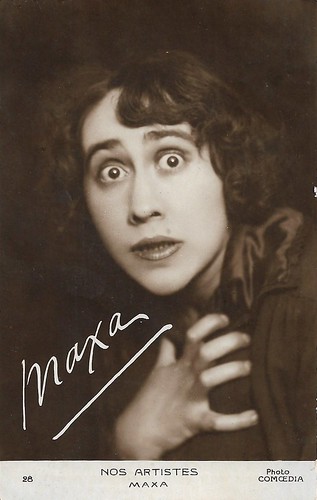
French postcard in the Nos Artistes series by Edit. Art de Comoedia, no. 28. Photo: Comoedia.
French stage and screen actress Maxa aka Paula Maxa (1898-1970), was nicknamed "the most murdered woman in the world". Mademoiselle Maxa debuted on screen as Laure, the maid of Moréno in Louis Feuillade's crime serial Les vampires (1915-1916). She then played in four French silent films: L'ibis bleu (Camille de Morlhon, 1918), Les chères images (André Hugon, 1920), in which she had the female lead opposite Jean Angelo, La révoltée (Gaston Leprieur, 1920), and finally, Hugon's Fille de rien (André Hugon, 1921). IMDb notes in its Trivia section: "The directors of her time appreciated her excessive gestures, her screams of terror (obviously mute), which accompanied two expressive and watery bulging eyes in their excellent simulation of panic and the hysteria of being killed. For these qualities, she was chosen to be killed in films up to 350 times [this could be contested, as she only appeared in a handful of films]. But in her true career, the theatre, she died on stage up to 30,000 times. A record." Indeed, between 1917 and 1933, Maxa specialised in victims in Grand Guignol plays. Maxa's main stage partner at the Grand Guignol was Georges Paulais. She sometimes left her favourite roles for less bloody productions, boulevard comedies, and some film roles. In 2018 a Belgian Netflix film was made about her, La femme la plus assassinée du monde/The Most Assassinated Woman in the World (Frank Ribière, 2018), staring Anna Mouglalis.
Rahna
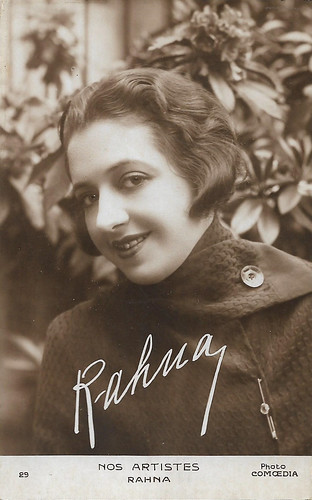
French postcard in the Nos Artistes series by Edit. Art de Comoedia, no. 29. Photo: Comoedia.
Marcelle Rahna aka Rahna and La jolie Rahna, was a French revue dancer, singer and actress in the 1920s. In 1923, she performed at the Palace Theatre in Paris with dancer Harry Pilcer in 'L'après-midi d'un Faune', based on the music by Claude Debussy. The year after, she performed with Pilcer, Polaire and Peggy Vere at the Palace in the revue 'Toutes les femmes'. In 1924 she also debuted in cinema, as la Camargo in the seven episodes of the serial Mandrin (Henri Fescourt, 1924), starring Romuald Joubé and produced by Société des Cinéromans. She played a dancer in La Clé de voûte (Roger Lion, 1925) and again as a dancer in Le P'tit Parigot (René Le Somptier, 1926). In 1930 Rahna sang in the revue 'Nudist'bar' (the French version of the Austrian revue 'Die Wunder-Bar). The last time Marcelle Rahna appeared on the screen was in the documentary Montmartre, village d'amour (1932).
Pierre Magnier

French postcard in the Nos Artistes series by Edit. Art de Comoedia, no. 30. Photo: Comoedia.
Pierre Magnier (1869-1959) was a French stage and screen actor and director, acting in over 100 films and known for La roue (Abel Gance, 1923), Cyrano de Bergerac (Augusto Genina, 1923) and La règle du jeu (Jean Renoir, 1939). In 1900 he debuted on-screen in Hamlet's Duel, a short dialogue between Hamlet and Laertes, with Sarah Bernhardt playing Hamlet. With Bernhardt, Magnier also acted in the plays 'Théodora' (1902) and 'Théroigne de Méricourt' (1902) at Bernhardt's own theater. In 1906-1908, Magnier worked with Bernhardt's rival Réjane. In 1909, Magnier started a more substantial career as a film actor in 1909 at Pathé Frères, debuting in La Maison sans enfant (Georges Monca, 1909). He had the male lead in L'ambitieuse (Camille deMorlhon, 1912), the first of a whole string of films with de Morlhon, such as L'usurier (1913), La reine Margot (1914), and La marchande de fleurs (1915), often opposite Léontine Massart. After a few more Pathé films, including L'ibis bleu (Camille deMorlhon, 1919) with Paule Maxa, he moved to Eclipse and appeared with Suzanne Grandais in Le siège des trois K (Jacques de Baroncelli, 1919). Memorable was his - supporting - part as Jacques de Hersan in La roue (Abel Gance, 1922), starring Séverin-Mars. Magnier had the male lead in Cirano di Bergerac/Cyrano de Bergerac (Augusto Genina, 1923), with Linda Moglia as Roxanne, and Angelo Ferrari as Christian. After a few more silent films, Magnier quit film acting and only returned in 1930, when the sound film had set in. From then on, he mainly focused on film acting, less on stage acting. By now, he had become the 'older man' in film plots, e.g. playing Metternich in Le congrès s'amuse (Jean Boyer, Erik Charell, 1931). He acted in many comedies, e.g. with Fernandel. In 1939 he played a general in La règle du jeu/The Rules of the Game (Jean Renoir, 1939). During the 1940s and early 1950s, Magnier kept acting in minor parts.
Maxime Léry
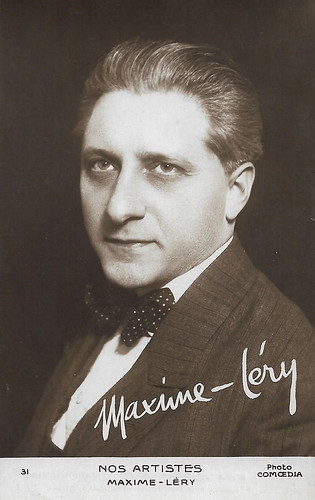
French postcard in the Nos Artistes series by Edit. Art de Comoedia, no. 31. Photo: Comoedia.
Maxime Léry (1884–1966) was a French stage and screen actor, and also a playwright. In 1913 he made his film debut at Pathé Frères as the leading actor in Le fils de Lagardère/The Heir of the Lagarderes (Henri Andréani, 1913), based on the eponymous novel by Paul Faval. After that, he only did a handful of scarce and minor parts in French silent and sound cinema.
Georges Milton

French postcard in the Nos Artistes series by Edit. Art de Comoedia, no. 33. Photo: Comoedia.
With his daring, merry songs, French singer and actor Georges Milton (1886-1970) expressed the atmosphere of the French roaring twenties. He peaked in the French cinema of the 1930s as the character Bouboule. On the advice of Maurice Chevalier, he did singing tours, which earned him immediate success, becoming one of the headliners of the main Parisian café concerts. He also played small parts in four silent films by Henri Diamant-Berger in 1923, all with Maurice Chevalier in the lead. After a revue at La Cigale, Milton turned to operetta. The huge success of the songs 'La Fille du bédouin' and 'Artichauts' from the operetta 'Comte Obligado!' (1927) propelled Milton to stardom. The arrival of sound cinema created a new career for Georges Milton. He created the character of ‘Bouboule’, a French middle-class Joe, who became the optimistic and joyful hero of a series of films. In the film adaptation Le Comte Obligado (André Mathot, 1934), Milton perfectly incorporated the ‘petit Parisien’, enormously dynamic, despite his lack of size and classic beauty. With its air of ‘average Frenchman’, he acted at least in one film a year in the 1930s. Milton retired after the war.
Georges Paulais
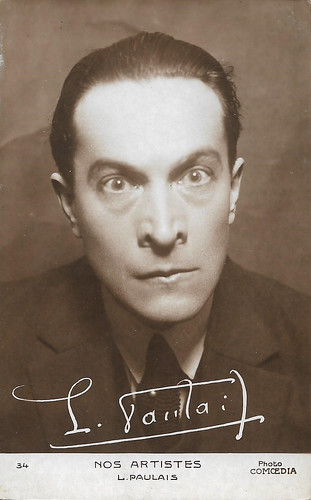
French postcard in the Nos Artistes series by Edit. Art de Comoedia, no. 34. Photo: Comoedia. As Paulais' first stage name was Georges, the signature on this card looks odd.
French actor Kléber Paulais (1884-1967) was known as Georges Paulais. After a successful career in the theatre, where he was the favourite interpreter of André de Lorde's dramas at the Grand-Guignol, the cinema called upon Georges Paulais and his deep bass voice from the beginning of the talking era. His impressive filmography is made up largely of modest, notable appearances, and spans from 1910 to 1968. In 1910-1911 he debuted at Pathé Frères where he played in dozens of shorts, directed by Albert Capellani, Georges Denola, and others. Afterward, he acted at Eclair in 1912, and again in 1914. In the later 1910s and 1920s, he had major supporting parts in Le droit de la vie (Abel Gance, 1917), Eldorado (Marcel L'Herbier, 1921), the serial Belphegor (Henri Desfontaines, 1927), and La merveilleuse vie de Jeanne d'Arc (Marco de Gastyne, 1929). In the sound era, Paulais had major parts in Accusée... levez-vous! (Maurice Tourneur, 1930) starring Gaby Morlay, Coeur de lilas (Anatole Litvak, 1932), La porteuse de pain (René Sti, 1934) starring Germaine Dermoz, and Rigolboche (Christian-Jaque, 1936) with Mistinguett, often playing lawyers and judges. Paulais had a steady, continuous career in French cinema till the early 1950s. His last part was in René Clément's Gervaise (1956).
Other Nos Artistes series
Polin

French postcard in the series Nos Artistes, no. 251. Picture: J. Bertin.
French comedian Polin (1863-1927) was one of the greatest stars of the café-concerts of Paris. His interpretations were sober and had nuance and finesse, which were rare in the café-concerts. From 1910 on, he also appeared in film and theatre, including Sacha Guitry's play Le Grand Duc/The Grand Duke (1921) with Lucien and Sacha Guitry, and Yvonne Printemps.
Gilberte Savary

French postcard in the Nos Artistes series. Caption: Jeune Vedette des Films Parlants (Young star of the sound cinema).
French child actress Gilberte Savary (1921-1992) appeared in six films between 1928 and 1934. She made her film debut as a little girl in the silent film La faute de Monique/Monique’s fault (Maurice Gleize, 1928), with Sandra Milovanoff and Rudolf Klein Rogge. The following year, she had a small part in the Alexandre Dumas adaptation Le collier de la reine/The Queen's Necklace (Tony Lekain, Gaston Ravel, 1929) starring Marcelle Chantal and Diana Karenne. She had one of the leading roles in the circus drama La ronde des heures/Round of Hours (Alexandre Ryder, 1931) as the daughter of clown André Baugé. The success of the film made her a child star and in 1931, she appeared in a total of four films. One was a bit role in Tout ça ne vaut pas l'amour/All that is not worth the love (Jacques Tourneur, 1931) with Marcel Lévesque and the young Jean Gabin both falling in love with Josselyne Gael. In 1923, director Jacques de Baroncelli had made the fairy tale-like Le rêve/The Dream (1923), a silent film version of the sixteenth volume in Emile Zola's Rougon-Macquart saga. In 1931 he made a sound version, Le rêve/The Dream (1931), now with Savary as a lost child who is adopted by a humble family. When she has grown up, the girl (now played by Simone Genevois) falls in love with the bishop's son (Jaque Catelain), and the old man who plans a beau marriage is not prepared to accept it. Finally in her last film appearance, Savary played the young Eponine Thénardier in the epic Les Miserables (Raymond Bernard, 1934) starring Harry Baur as ex-convict Jean Valjean and Charles Vanel as the obsessive police inspector Javert. Now an adolescent, Gilberte retired from the screen.
Lucienne Waldor
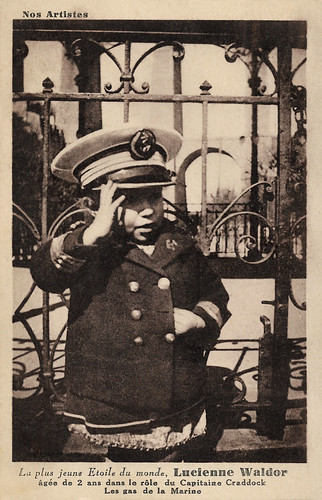
French postcard in the Nos Artistes series. Lucienne Waldor in Les gars de la Marine. Caption: the youngest star in the world, Lucienne Waldor, aged 2, in the role of Captain Craddock, singing Les gars de Marine. The -r has been forgotten on this card.
In 1933 Lucienne Waldor aka Lulu, real name Lucienne Sangan, born Lambec, was promoted as the French Shirley Temple. With her parents Lucien Waldor and his wife, her elder brother Jackie Waldor and other family members (brothers Lucky and Robert and cousin Jackson), she performed as the 'Troupe Waldor", e.g. as live intermezzo in cinemas, singing, dancing, and playing instruments, and touring all of France. Apparently, they were so popular that a boy was knocked over by a car when running out to see the family passing. Lucienne Waldor's life was haunted by car accidents. In 1937 the family had a bad car accident when returning from St. Dizier to Paris a tire exploded and the car crashed into a tree. Particularly the parents were gravely hurt. On 20 September 2019, at age 88, Lucienne Waldor was killed herself by a truck when crossing a zebra in front of the train station of St. Raphael, in a zone where trucks without special permits were forbidden.
Sources: Wikipedia (French) and IMDb.
No comments:
Post a Comment